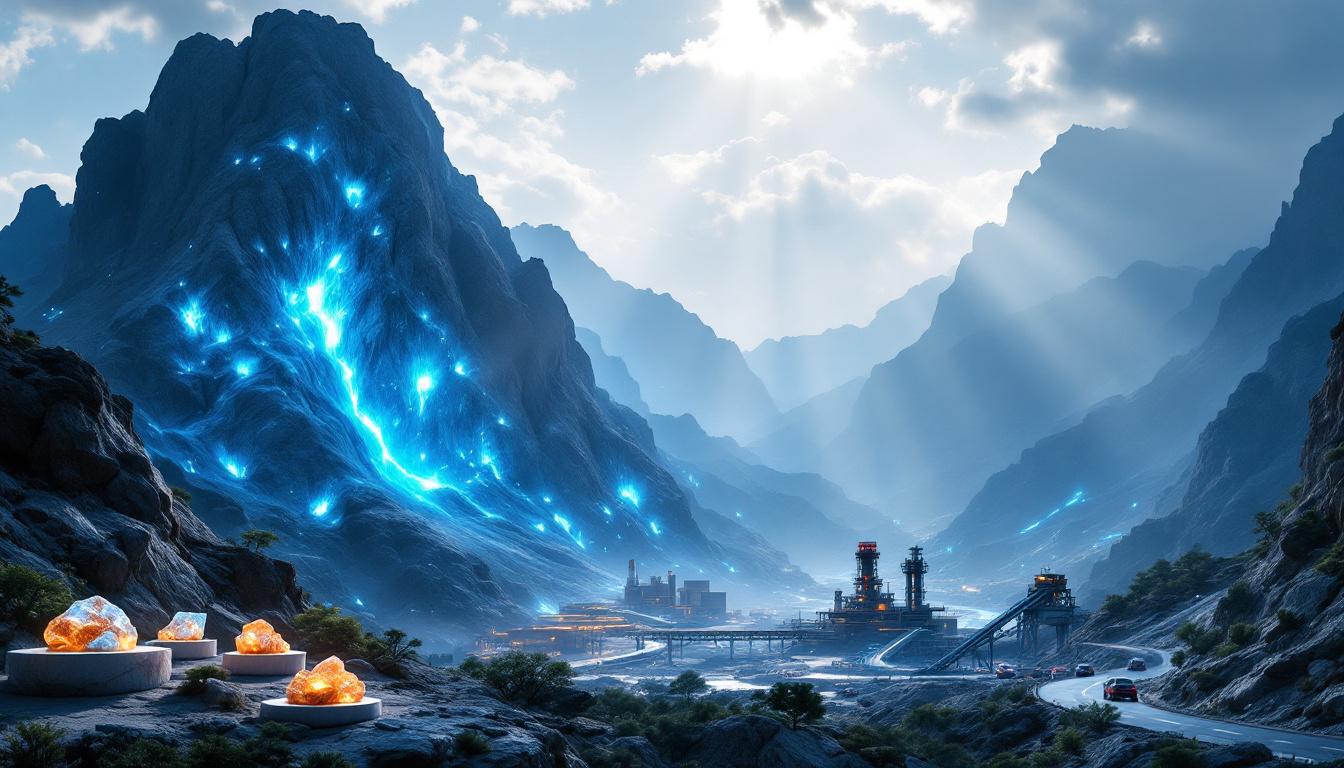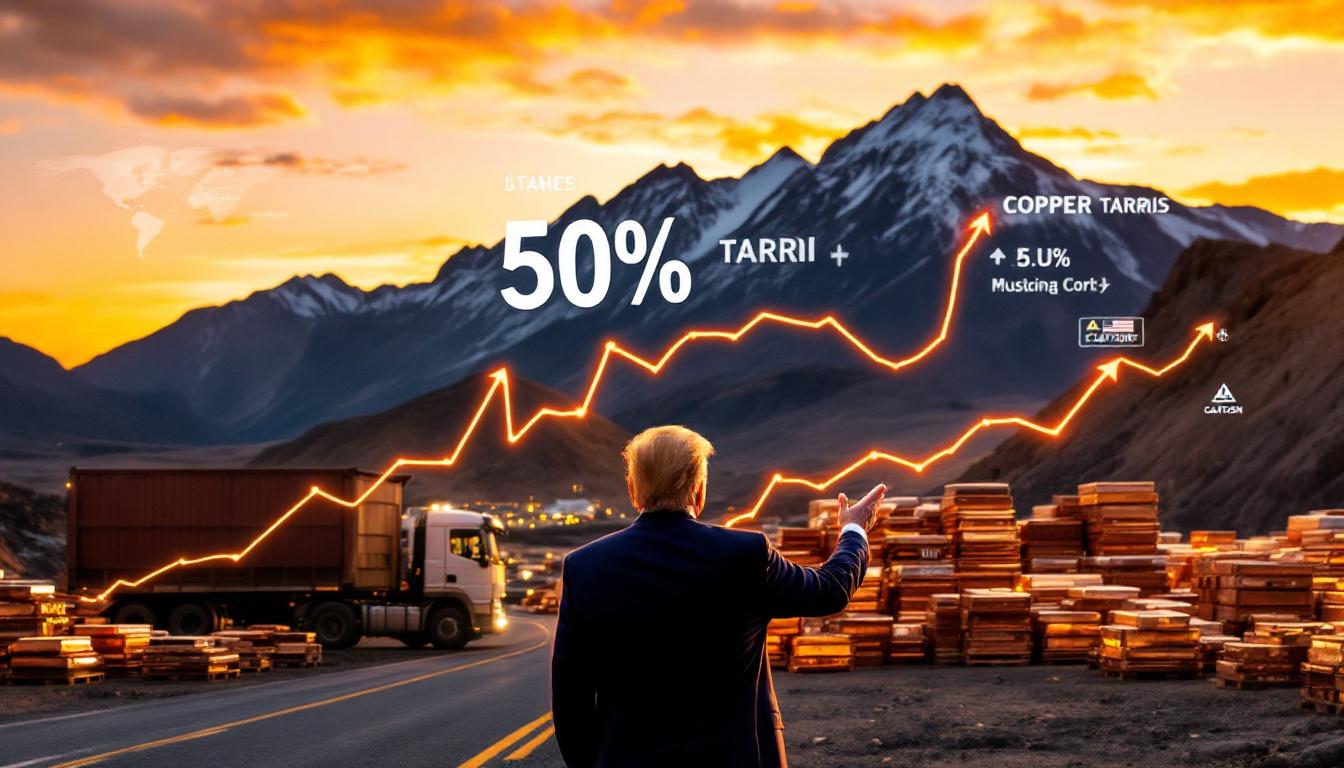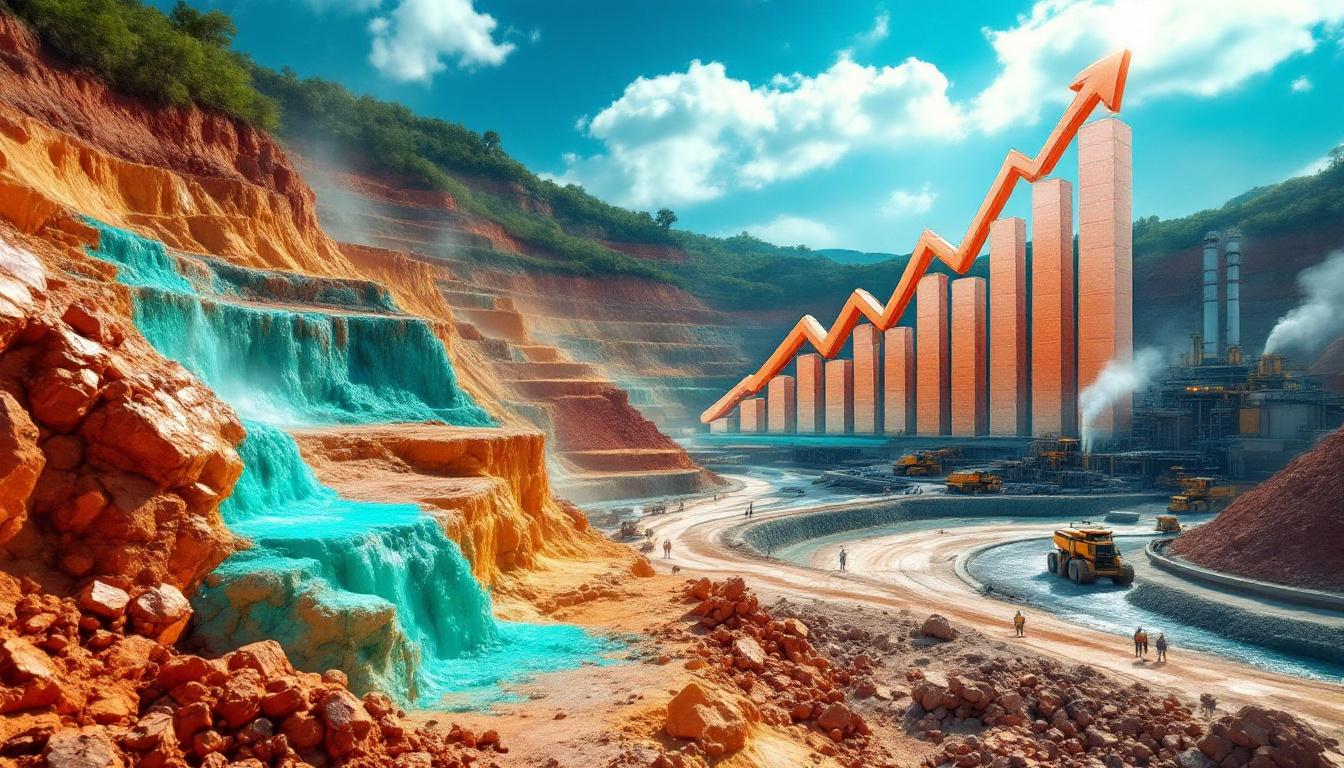Trump's Deep-Sea Minerals Strategy: Countering China's Critical Minerals Dominance
The Trump administration is drafting a groundbreaking executive order that would enable the United States to stockpile critical minerals harvested from the Pacific Ocean seabed. According to an April 13, 2025 Financial Times report, this bold initiative aims to counter China's stranglehold on the global critical minerals market by tapping into the vast, largely unexploited resources beneath international waters.
This strategic pivot represents one of the most significant shifts in U.S. resource policy in decades, directly challenging China's Critical Mineral Export Restrictions and dominance in a sector vital to everything from electric vehicles to advanced defense systems.
What Is Trump's New Executive Order on Deep-Sea Minerals?
The executive order, currently in its final drafting stages, establishes a framework for creating a national strategic reserve of ocean-floor minerals. The initiative specifically targets polymetallic nodules—potato-sized rock formations scattered across vast areas of the deep ocean floor, particularly in the Clarion-Clipperton Zone (CCZ) between Hawaii and Mexico.
These nodules contain concentrated deposits of battery metals and rare earth elements that are crucial for the green energy transition and advanced technology manufacturing. Industry experts estimate the CCZ alone contains enough nickel, cobalt, manganese, and copper to electrify the entire global vehicle fleet several times over.
"The administration recognizes that whoever controls these critical minerals controls the future of technology," said Dr. Rebecca Hyland, former USGS minerals specialist. "This executive order signals that the U.S. is no longer willing to cede that future to Beijing."
Why Deep-Sea Minerals Are Strategically Important
The Critical Minerals at Stake
Deep-sea polymetallic nodules represent one of the largest untapped mineral resources on the planet. These nodules typically contain:
- Nickel (1.3% average grade): Essential for EV batteries and stainless steel
- Cobalt (0.2% average grade): Critical battery component facing severe supply constraints
- Copper (1.1% average grade): Fundamental to all electrical systems
- Manganese (27.9% average grade): Key ingredient in steel manufacturing
- Trace rare earth elements: Required for everything from smartphones to missile guidance systems
What makes these nodules particularly valuable is their remarkable composition—they often contain higher grades of these metals than terrestrial mines, and they form naturally on the ocean floor rather than requiring environmentally destructive overburden removal.
"The mineral concentrations in these nodules are extraordinary," explains marine geologist Dr. Thomas Marwick. "A single 4cm nodule can contain more cobalt than processing a ton of land-based ore in some cases."
China's Current Mineral Dominance
China's mineral supremacy represents perhaps the most significant supply chain vulnerability facing Western economies:
- China controls approximately 70% of global rare earth mineral production, according to the US Geological Survey
- More critically, it dominates nearly 90% of the world's rare earth processing capacity
- For battery metals like cobalt and nickel, Chinese companies have secured controlling interests in mines across Africa and Indonesia
- In 2024, China processed 72% of the world's nickel and 65% of its cobalt
Beijing has already demonstrated its willingness to weaponize this advantage, implementing export restrictions on gallium, germanium, and certain rare earth elements during recent trade tensions. These restrictions sent prices soaring—neodymium prices jumped 85% in just three months following export quotas implemented in late 2024.
"China's mineral dominance isn't accidental—it's the result of a deliberate, decades-long strategy," notes defense analyst Martin Rothwell. "They recognized early that these elements would become the 'new oil' in a technology-driven world."
How Will the Strategic Reserve Work?
The "Strategic Reserve" Concept
The proposed mineral reserve draws inspiration from existing strategic stockpiles like the Strategic Petroleum Reserve and the National Defense Stockpile. However, it introduces several innovative elements:
- Three regional storage hubs located in the Gulf Coast, Pacific Northwest, and Great Lakes regions
- Approximately 2.5 million square feet of specialized warehousing with controlled-atmosphere storage
- Initial stockpiling targets of 500,000 tons of processed minerals by 2028
- Public-private partnerships requiring companies to contribute a percentage of harvested minerals to the national reserve
- Blockchain-enabled inventory tracking system integrated with the Defense Department's Project Spectrum
"This isn't just about warehousing rocks—it's about creating a complete ecosystem for mineral security," explains supply chain expert Danielle Chen. "The administration is attempting to replicate the petroleum reserve model but with additional focus on processing capability."
Implementation Timeline and Process
The executive order outlines an ambitious implementation schedule:
- Phase 1 (2025-2027): $2.1 billion allocated for seabed surveying and permitting framework
- Phase 2 (2027-2030): Development of domestic processing capacity with $850 million from the Inflation Reduction Act
- Phase 3 (2030-2035): Full-scale nodule harvesting operations and strategic stockpile expansion
This timeline dovetails with the March 2025 executive order activating the Defense Production Act to accelerate domestic mining and processing. Together, these orders create a comprehensive framework for mineral independence.
What Are the Regulatory Implications?
Bypassing International Authorities
Perhaps the most controversial aspect of the proposed order is its approach to international regulation. According to Reuters, the administration is considering allowing U.S. companies to bypass the International Seabed Authority (ISA)—the UN-backed organization responsible for regulating deep-sea mining in international waters.
Instead, companies would apply directly to the National Oceanic and Atmospheric Administration (NOAA) for expedited permits, with decisions expected within 90 days versus the ISA's typical 5-year process.
This approach relies on a novel interpretation of Article 76 of the United Nations Convention on the Law of the Sea (UNCLOS), potentially allowing mineral leases in waters adjacent to the U.S. Exclusive Economic Zone—though legal experts warn this could clash with the 1994 Deep Seabed Implementation Agreement.
"The administration is essentially creating a parallel regulatory regime," explains maritime law expert Professor James Harrington. "It's a high-risk, high-reward strategy that will almost certainly face legal challenges in international forums."
Connection to Onshore Mining Initiatives
The deep-sea initiative complements the administration's broader efforts to revitalize domestic mining and processing:
- The March 2025 Defense Production Act activation provides $3.2 billion in loan guarantees for critical mineral projects
- Streamlined permitting for 14 specific rare earth and battery metal mines on federal lands
- Tax incentives for companies establishing processing facilities in designated "mineral security zones"
- Research funding for alternative extraction technologies, including $200 million for artificial nodule generation research
"The administration is pursuing a two-track strategy," notes mining policy analyst Sarah Jenkins. "They're simultaneously trying to accelerate traditional mining while opening this entirely new frontier beneath the waves."
What Industry Leaders Are Saying
The executive order has elicited strong reactions across the mining and technology sectors. The CEO of The Metals Company, a leading deep-sea mining venture, described the policies as "the best news for deep-sea mining in the company's history," noting that they recently secured a $300 million nodule processing deal in anticipation of accelerated development.
Other industry reactions have been similarly enthusiastic:
- Lockheed Martin's UK subsidiary has doubled orders for offshore mining equipment
- Patent filings for deep-sea mining technologies have surged 78% since March 2025
- Several major mining companies have announced plans to enter the deep-sea sector
"This is the starting gun for a new era in resource extraction," states Gerard Montgomery, CEO of DeepResource Technologies. "Companies that have been developing these technologies for years suddenly have a clear path to commercialization."
However, environmental groups have expressed serious concerns about the ecological impacts of seabed mining, citing studies showing potential 40% sediment plume spread beyond mining zones and 15% mortality rates for abyssal marine life in trial areas.
Technological Challenges and Innovations
The Engineering Frontier
Harvesting minerals from 4,000-6,000 meters beneath the ocean surface presents unprecedented engineering challenges. Several companies are racing to develop commercially viable collection systems:
- Allseas' hidden pick-up system currently achieves 400 tons per hour collection rates
- The MIT-developed "soft touch" collector reduces seabed disturbance by 65%
- Autonomous underwater vehicle (AUV) swarms being tested for pre-collection surveying
Processing these nodules also requires specialized approaches. Emerging technologies include:
- Electrolytic extraction achieving 94% manganese recovery rates
- Bioleaching techniques that reduce energy requirements by 40%
- High-pressure acid leaching adapted specifically for nodule composition
A 2025 MIT study projects that these technologies could reach 35% cost parity with land-based mining by 2030, potentially revolutionizing the economics of mineral extraction. These developments represent a significant leap in digital innovation in mining practices worldwide.
Environmental Considerations
Balancing Resource Needs with Ocean Protection
The environmental impacts of deep-sea mining remain contentious. Proponents argue that seabed mining actually has a lower environmental footprint than terrestrial mining when measured holistically:
- No deforestation or habitat destruction
- No toxic tailings dams that can catastrophically fail
- Lower carbon footprint per ton of metal produced
- No displacement of communities or indigenous peoples
However, marine biologists have raised significant concerns:
- Disturbance of deep-sea ecosystems that remain largely unstudied
- Potential extinction of species before they're even discovered
- Sediment plumes that could affect areas far beyond mining zones
- Noise pollution affecting marine mammals
The Trump administration's order attempts to address these concerns with a $200 million environmental mitigation fund, though critics argue this is insufficient given the scale of potential impacts. These challenges add another layer to the broader ESG challenges in mining that the industry currently faces.
FAQ: Deep-Sea Mining and Critical Minerals
What are polymetallic nodules?
Polymetallic nodules are rock concretions that form gradually on the deep seabed over millions of years. They range from marble to potato size and contain valuable minerals including nickel, cobalt, copper, and manganese, along with traces of rare earth elements. They form through a process where minerals dissolved in seawater precipitate around a core object (often a shark tooth or bone fragment) at rates of approximately 1-10mm per million years.
Why is reducing dependence on China's minerals important?
China's mineral dominance represents a significant national security vulnerability. During recent trade tensions, China demonstrated willingness to use its supply control as leverage, implementing export restrictions that sent prices soaring. These minerals are essential for defense systems, renewable energy technologies, and next-generation electronics. A disruption in supply could cripple U.S. manufacturing and military readiness.
The Pentagon's 2024 Supply Chain Report identified 14 critical minerals where China controls more than 50% of global production or processing—a situation the report described as "an unacceptable strategic vulnerability."
How does deep-sea mining compare to traditional mining?
Deep-sea mining and traditional terrestrial mining represent fundamentally different approaches to resource extraction:
Deep-sea mining:
- Targets loose nodules sitting on the ocean floor rather than embedded ore
- Requires specialized collection vehicles but minimal processing to separate ore from waste
- Operates in remote international waters with no human communities
- Higher-grade deposits but higher extraction costs
- Novel environmental challenges in largely unstudied ecosystems
Traditional mining:
- Involves removing overburden, often requiring deforestation
- Creates large open pits or underground tunnels
- Generates significant tailings that must be contained
- Well-understood but substantial environmental impacts
- Often affects local communities and water resources
What is the Defense Production Act?
The Defense Production Act (DPA) is a federal law that gives the president broad authority to direct private companies to prioritize orders from the federal government. Originally passed during the Korean War, the DPA allows the government to:
- Require companies to accept and prioritize contracts for materials deemed necessary for national defense
- Allocate materials, services, and facilities to promote national defense
- Authorize loan guarantees and direct loans to expand production capabilities
- Establish voluntary agreements with private industry
In the context of critical minerals, the Trump administration has activated Title III of the DPA, which provides financial incentives to develop, maintain, or expand domestic production capacity. The March 2025 DPA activation specifically targets rare earth elements, battery metals, and processing technologies with $3.2 billion in loan guarantees.
The Global Race for Seabed Resources
While the U.S. moves to establish its own regulatory framework, other nations are pursuing their own deep-sea mining strategies:
- China has secured five exploration contracts through the ISA and is building specialized vessels
- Japan has completed pilot mining operations near Okinawa focused on copper-rich sulfide deposits
- Norway recently opened its continental shelf to mineral exploration
- The UK maintains significant interests through companies like UK Seabed Resources
Goldman Sachs' April 2025 metals forecast suggests that successful implementation of the U.S. strategy could displace 12-18% of Chinese rare earth exports by 2035, fundamentally altering global resource dynamics.
As this new frontier in resource extraction develops, the Trump administration's deep-sea minerals strategy represents a watershed moment in the ongoing competition for the critical materials that will power the 21st century economy. For investors looking to navigate this changing landscape, understanding various mining investment strategies will be crucial as we move toward the 2025 mining industry predictions that suggest continued growth in this sector.
Ready to Catch the Next Major Mineral Discovery?
Stay ahead of the curve with real-time alerts on significant ASX mineral discoveries, powered by Discovery Alert's proprietary Discovery IQ model. Explore why major discoveries like those mentioned in Trump's critical minerals strategy can generate substantial returns by visiting Discovery Alert's dedicated discoveries page.




